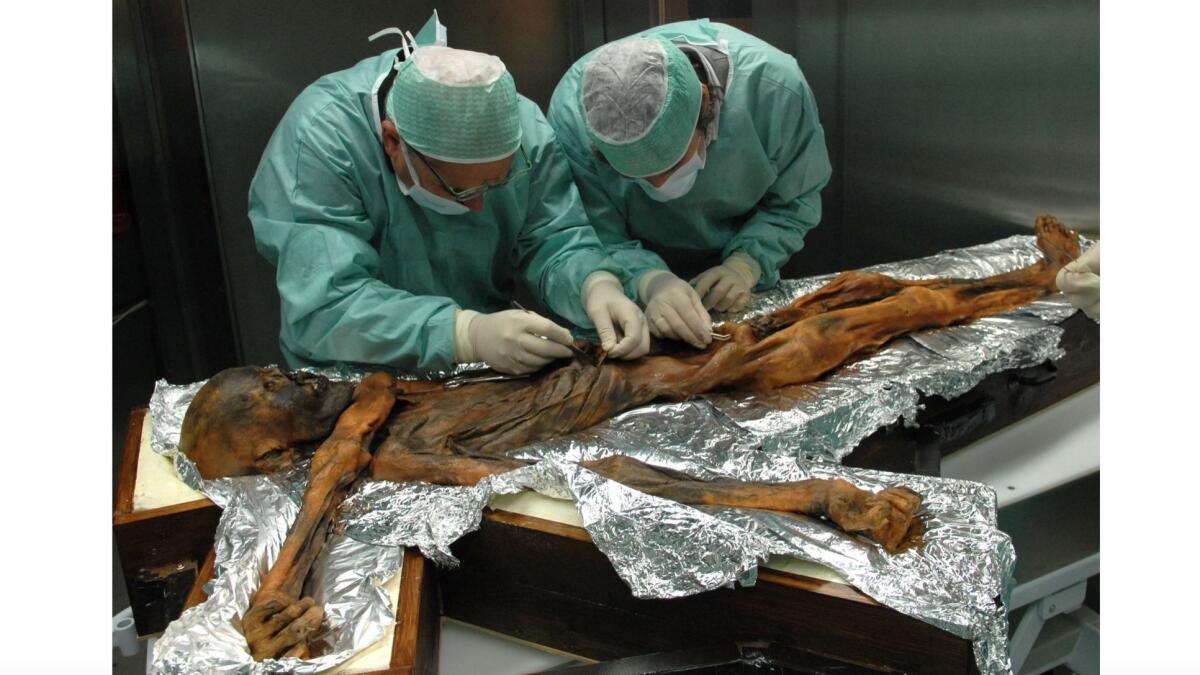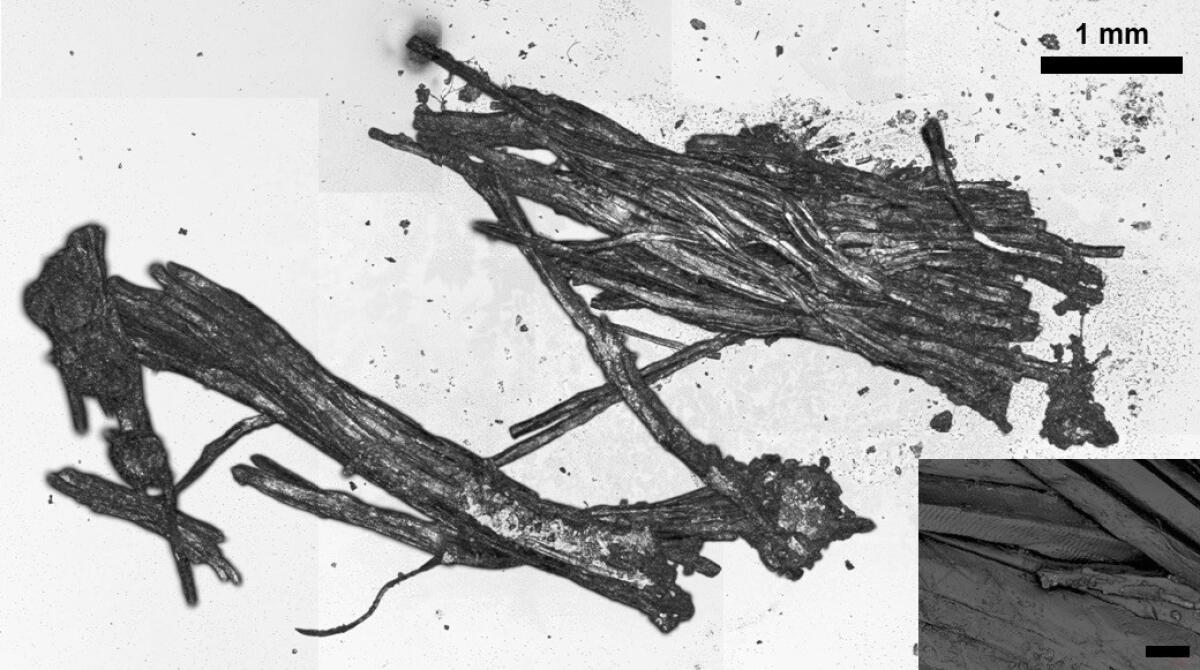Though he lived 5,000 years ago, Otzi the Iceman was not a strict adherent to the Paleo diet

If you were thinking that the ancient Alpine traveler known as Otzi — and often known simply as Iceman — scraped by on a diet of foraged grasses and berries, you’d be very wrong.
A comprehensive new study of his stomach contents reveals that Otzi, who perished roughly 5,300 years ago on a mountain in the Eastern Alps of Italy, died with a belly full of fatty meat, some whole seeds from the einkorn wheat plant, and maybe a bit of goat’s milk or cheese — all eaten just a couple of hours before he died.
Judging from the remnants of plant spores found in his gut, the Iceman may have set off from home with a mobile meal of smoked or dried meat wrapped in the large, coarse leaves of a bracken fern.
It was not a bad picnic for a peripatetic member of a primitive society of hunter-gatherer-farmers. There were traces of herbs, perhaps used to flavor the meat or a bread made from grains we would now call “ancient.” The meat came from an ibex — a wild goat species also known as the steinbock — and red deer, both plentiful in the area.
So much for some researchers’ conviction, based of an early analysis of his hair, that Otzi was a vegetarian.
Close to half of what remained in his stomach was fat from the meats he consumed. That fat would have given his last meal the luxurious mouthfeel of bacon.
The muscle-and-heart meat would have delivered the satiating properties of protein. It was fuel well-suited to the rigors of stalking, hunting and possibly shepherding animals in the cold, high Alps.

In time, this fatty, carnivorous diet would probably have clogged Otzi’s arteries, and evidence that this process was already underway has come from earlier research. But since Iceman was unlikely to survive into anything resembling modern-day old age, that would probably not have been the death of him. (He is estimated to have been roughly 45 when he died and had probably outlived most of his contemporaries.)
As food-packaging goes, bracken fern is a more questionable choice: It can cause bleeding and anemia when ingested.
But what killed Otzi in the end appears to have been an arrow to the back. And what happened at some point following his death — either a deliberate burial or a final accidental fall into a glacial ravine — caused his remains to be frozen and mummified until their discovery by hikers in 1991.
Dr. Gregory S. Thomas, a cardiologist with MemorialCare Heart and Vascular Institute in Long Beach who has studied ancient specimens to discern the roots of heart disease, calls Otzi “the best preserved ancient mummy ever discovered.” The new findings, reported Thursday in the journal Current Biology, will inspire scientists “to look into the last meals of mummies from other ancient cultures,” he said.
Thomas, who was not involved in the research, added that the study will help answer age-old questions of universal interest: What is an ideal diet, and how does what we eat influence our health, energy, and ability to survive in the spaces and times we inhabit?
Preserved in ice for millenniums and thawed out only for the occasional well-planned study, Otzi has given the modern world its best-ever chance to explore the everyday realities of life during the Chalcolithic era. Stretching from roughly 3500 to 2300 BE, that tumultuous period marked Southern Europe’s transition from primitive farming with stone tools to civilizations that forged metals, expanded trade and ushered in complex modern societies.
Iceman’s mummified remains have been intensively studied, and earlier surveys had already yielded some clues about his diet. But those analyses had focused on the contents of Iceman’s lower intestines, the largely digested remains of food eaten at least eight hours earlier, including deer meat, grains and fruit.
Those studies also showed that Iceman was infected with an intestinal parasite called whipworm, and that he was lactose intolerant. And they helped trace a turning point in humankind’s dental health: the introduction of grain-derived carbohydrates, which probably had deposited cavity-causing sugars on Iceman’s teeth.
The new analysis was made possible by the discovery of Iceman’s stomach, which had inexplicably migrated upward during the mummification process.

Researchers from the Institute for Mummy Studies in Bolzano, Italy, where Iceman’s remains are stored, spotted the elusive stomach when they were reviewing CT scans in 2009. That prompted an intensive analysis of its contents. The team, led by Frank Maixner and Albert Zink, employed methods ranging from microscopic observation to genomic analysis.
Otzi’s final meal, the authors concluded, was “a well-balanced mix of carbohydrates, proteins and fats perfectly adjusted to the energetic requirements of his high altitude trekking.”
The tools brought to bear in the new study gave Maixner and Zink the ability “to examine the DNA, protein, carbohydrate and fat down to the atomic level,” Thomas said. “In the past, we could peer into a microscope and look at the meat of an ancient meal. But we could not examine the DNA, for example, to determine which animal it was, and which part of the animal.”
The findings touched off a new round of excited chatter among those who study ancient human cultures to discern the origins of heart disease.
“He would need the fat as an energy source, and I am sure he would have burned it off,” said Dr. Anthony Heagerty, a cardiologist and professor of medicine at the University of Manchester in England. Analyses of Otzi’s bones suggest that his lifestyle was far from sedentary and included long walks over hilly terrain.
“It is interesting that scans of the Iceman have shown major calcification in arteries and the aorta indicating an advanced state of atherosclerotic disease,” Heagerty said. In the end, he died violently, but “he too was in danger of heart attack,” Heagerty speculated.
Thomas is not so sure.
The meats found in Iceman’s belly — the heart and muscle meat of ibex and red deer — “were both wild and lean,” he said. And recent studies, including research on the cardiovascular health of the Tsimane people of lowland Bolivia, suggest that when it comes to heart disease, it may be the fat content of meat, more than the quantity consumed, that matters.
While the farmer-forager Tsimane eat about the same percentage of protein as in the typical American diet, the fat content of the meats they eat is about half of that found in farm-fed animals in the United States, Thomas said.
Finally, even at the then-advanced age of roughly 45, Otzi appeared to be “a lifetime athlete” for whom 10,000 steps a day “would likely be almost a warm-up,” he said.
“A subsistence hunter, his chief task would be finding food for himself, and if he had a family, for them as well,” Thomas noted. His daily exertions “would also be protective for his heart and overall health.”
MORE IN SCIENCE







